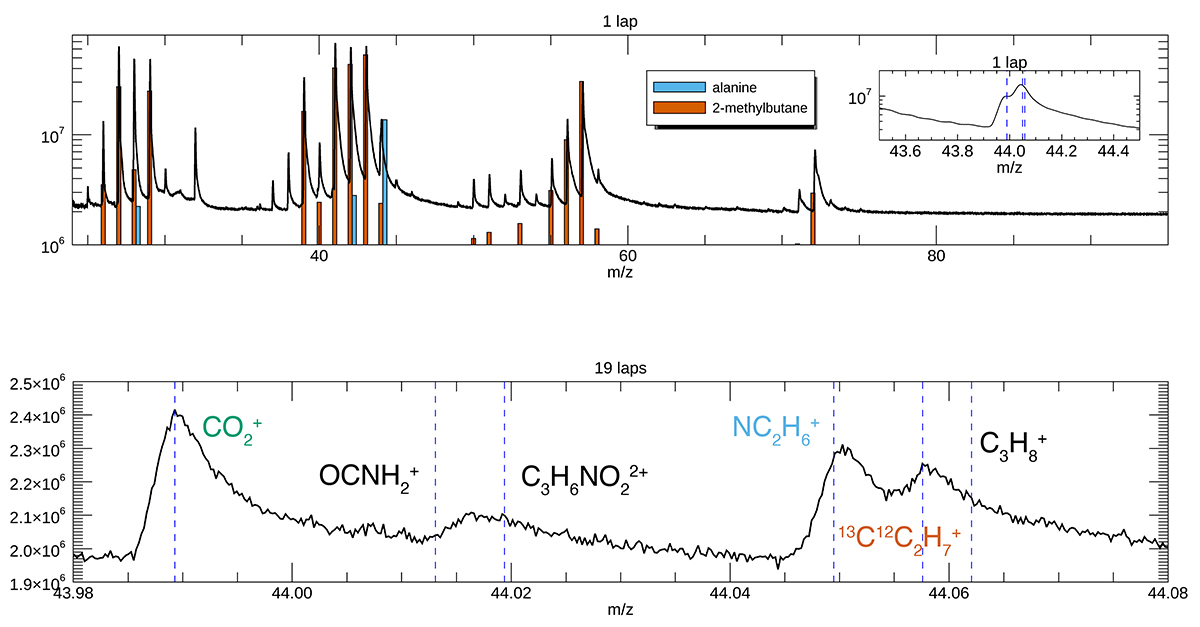Background
The MAss Spectrometer for Planetary EXploration (MASPEX) instrument is a neutral gas multi-bounce time-of-flight mass spectrometer (MBTOF-MS) designed for exploration of extraterrestrial environments. The instrument features the highest mass resolution to date for a spaceflight mass spectrometer, as well as high sensitivity and a suite of features optimized for the study of planetary origins and habitability. The first-generation instrument is slated to launch as part of the Europa Clipper payload in October 2024, and will collect data in the Jovian system with approximately 50 close flybys of the ocean world Europa. In this project, we have undertaken work to explore the application of MASPEX towards future mission targets such as Enceladus, an ocean world in the Saturnian system that is believed to be habitable and has an active plume that launches subsurface water 10s of kilometers above the surface.
Project work in 2023 focused on collection of proof-of-concept data for use of MASPEX to search for and identify organic molecules, and especially amino acids, which are of high interest as markers of habitability and even potential biosignatures. While these molecules are not typically considered gas-phase targets, the detection of the amino acid glycine in the coma of comet 67P/Churyumov-Gerasimenko by a neutral gas mass spectrometer was previously reported. The very low pressures in this extraterrestrial environment may have contributed to sublimation of glycine molecules from the icy grain surfaces. At Enceladus, amino acids may be lofted with other materials by the active plume to high altitudes, where sublimation may occur.
Approach
Previous data from the Cassini mission have revealed the molecular complexity of the Enceladus plume. To explore the ability of MASPEX to search for amino acids in a mixture, we tested measurement of a mixture of the amino acid alanine with 2-methylbutane, a hydrocarbon compound. The mass spectra of both compounds include a peak at 44 u. For alanine, this peak is attributed to NC2H6+, while for 2-methylbutane it is attributed to [13C][12C]3H7+. These two peaks differ in mass by 0.008 u, and we therefore sought to collect mass resolved spectra as confirmation of the presence of both compounds. For data collection, we utilized the MASPEX prototype instrument, MBTOF5. Our experimental set-up is shown in Figure 1. We introduced 2-methylbutane into the instrument housing via injection from a gas-tight syringe into a vacuum antechamber with a variable leak valve. Alanine was loaded into a metal capillary needle, and inserted through a septum into a heated transfer line. Measurements were made using a low-mass-resolution setting to confirm the presence of each compound, and then data were collected at high mass resolution to separate the target peaks at 44 u.

Figure 1: Laboratory set-up for measurement of alanine and 2-methylbutane mixture. The position of the heated transfer line, the volatiles antechamber for the 2-methylbutane, and the ion source inside the vacuum housing are labeled.
Accomplishments
The final dataset showing successful identification of the two compounds is presented in Figure 2. In the top panel, the MBTOF5 data for the mixture of alanine and 2-methylbutane are shown in black. The NIST fragmentation patterns are overlaid in the color bars. The inset shows a zoomed-in view of the 44 u peak in this lower mass resolution spectrum. CO2, which is a background constituent and may also be produced by oxidation of the organic compounds at the filament, is already partially resolved and is marked by the dashed blue line at the left. The position of the alanine and 2-methylbutane fragments are shown by the dashed blue lines at the right. In the bottom panel, the resolved spectrum of the same mixture is shown, clearly demonstrating the presence of both the hydrocarbon fragment (far right) and the N-bearing fragment from the amino acid. At left the CO2+ ion is visible. These data demonstrate the ability of MASPEX to search for and identify complex organic molecules that may be indicative of habitability.

Figure 2: Spectra showing the mixture of alanine and 2-methylbutane at lower mass resolution and a broad mass range (top) and at high mass resolution at 44 u (bottom).
